Go back in history to learn about the 5 Great Extinctions on Earth and find the solution to the 6th Great Extinction.
What is mass extinction?
Mass Extinction, also known as mass extinction , is the destruction of most members of a biological population in a very short geologic time.
In Earth’s 4.6 billion-year long geological history, there have been five major extinction events, and these five mass extinction events all occurred during the Phanerozoic – Epiterozoic Era (a period in chronology). geology in which abundant animal life has existed. It covers about 545 million years and begins at about the time when diverse hard-shelled animals first appeared. ongoing).
There was a time when the Earth seemed to have reached the End of the World when experiencing “uncomfortable changes” of nature. But in the end, the Blue Planet still proved its strong vitality by still standing firm after 5 Great Extinctions…
1. Ordovician – Silurian extinction
This was the first mass extinction, which occurred 440 – 450 million years ago. During this period, there were many consecutive extinctions that destroyed 17% of families and 50% of genera and was considered the second largest extinction in history if measured by the number of species destroyed.
In the Ordovician period, about 49% of marine animal genera disappeared completely when the extinction ended, and other animal phyla also declined significantly. To date, the most accepted hypothesis about the cause of the extinction is that a gamma-ray burst from a star near Earth caused carbon dioxide in the atmosphere to plummet. This affected the Earth, creating an ice age lasting 0.5 – 1.5 million years.
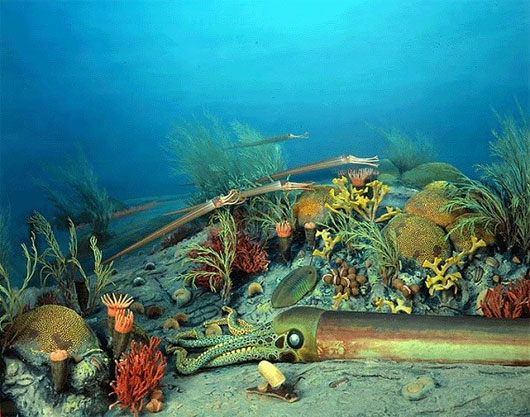
The rise and fall of sea level through successive cyclic ice ages has created many “ecological niches” on the continent. Biodiversity is gradually decreasing, especially species with limited habitats on the continental shelf and in the tropics are also greatly affected.
At the end of time, melting glaciers caused sea levels to rise. From here, the surviving orders and families will begin to recover, along with that, biodiversity will increase, opening a new era.
2. Devonian Extinction
There is archaeological evidence showing that this is a continuous extinction that may have lasted up to 20 million years. The extinction began about 360 million years ago, just before the transition from the Devonian to the Carboniferous period.
Before entering the extinction, the continent was the land of lower plants and the first insects, while the ocean was dominated by giant coral reefs and strong evolution of species. fish is going on.
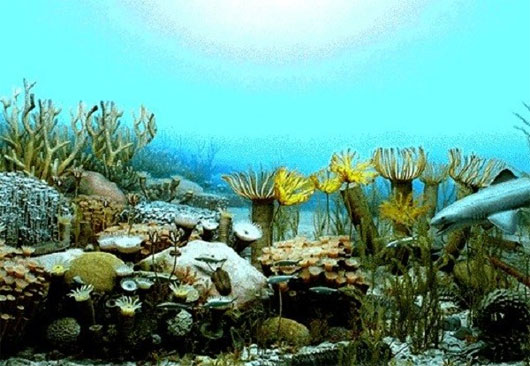
According to paleontologist McLaren, a large-diameter meteorite collided with Earth, causing tsunamis, devastating coastal ecosystems, and disturbing the deep sea layers.
Another reason is that the strong growth of plants has reduced CO 2 , causing the climate to become colder, and many organisms that cannot adapt have been destroyed.
Marine creatures are the main victims: coral reefs – the home of marine life – die en masse, leading to the extinction of many species. It is estimated that about 19% of families, 50% of genera and 70% of species were exterminated in this extinction.
3. Permian – Triassic extinction
This is the most terrible extinction event in history, destroying most creatures on Earth and resetting almost the entire biological system. Paleontologists say that more than 90% of marine creatures and 70% of terrestrial creatures were completely wiped out.
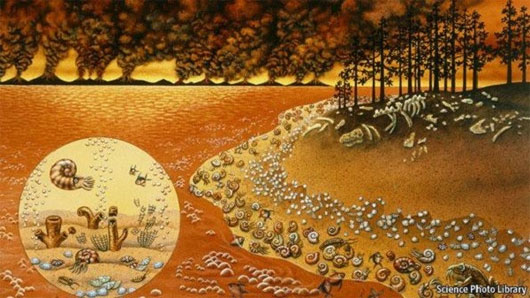
Archaeological evidence shows that the main cause of the above phenomenon is the strong tectonic movement of the Earth’s crust, causing cracking and compression of the continental plates.
The eruption of magma onto the Earth’s surface engulfed everything in flames. Besides, dust and carbon dioxide fill the air, causing a greenhouse effect that makes the Earth hotter than ever. Under the ocean, changing ocean currents have disappeared many ecosystems, making life extremely fragile.
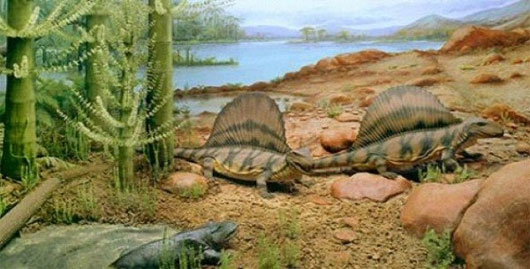
Another cause believed to contribute to this bloody mass extinction is the collision of a meteorite with a radius of 500km with Earth. Traces of this collision were found in Antarctica in 2006 by scientists at Ohio State University, USA.
It took a long time for life to gradually be restored from the lucky small creatures that survived, including some groups of reptiles.
4. Triassic – Jurassic extinction
This is the extinction that marks the boundary between the Triassic and Jurassic periods, occurring 199.6 million years ago. This mass extinction has a profound impact on biological life on land and in the ocean.
Many species of ocean vertebrates and marine reptiles have disappeared, except for ichthyosaurs and copepods. Invertebrates such as brachiopods, molluscs, amphibians and especially archaeosaurid reptiles (except dinosaurs) on the mainland were also severely affected. About 23% of families and 48% of genera have become extinct.

It is still uncertain what caused the end-Triassic extinction event. Scientists predict that a large volcanic eruption has occurred. However, recently, studies have shown quite accurately the time period when the extinction took place and the meteor collision created Lake Manicouagan (Canada). This evidence proves that the collision may have been the direct cause of this extinction.
The extinction event eliminated many large animal species on Earth, creating conditions for dinosaurs to dominate the planet during the Jurassic and Cretaceous periods. Dinosaurs dominated the entire land, while freshwater areas were the territory of the ancestors of today’s crocodiles (a subclass of lizards), snake-necked lizards and ichthyosaurs that became the kings of the sea. .
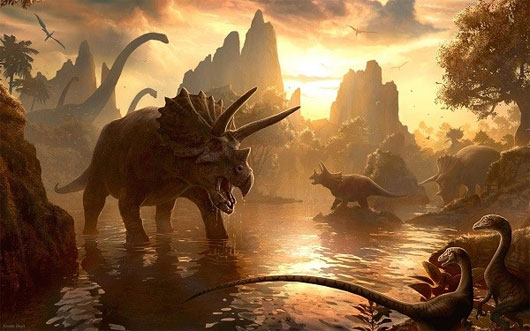 The extinction ushered in the heyday of reptiles with the dominance of dinosaurs
The extinction ushered in the heyday of reptiles with the dominance of dinosaurs
However, when the age of reptiles was extremely prosperous, the Earth encountered the next disaster – the Cretaceous – Paleogene great extinction.
5. Cretaceous – Paleogene extinction
This extinction event occurred at the end of the Cretaceous period about 66.5 million years ago, marking the end of the Mesozoic Era and the beginning of the Cenozoic Era with the Paleogene period. About 17% of families, 50% of genera and 75% of species became extinct after this event.
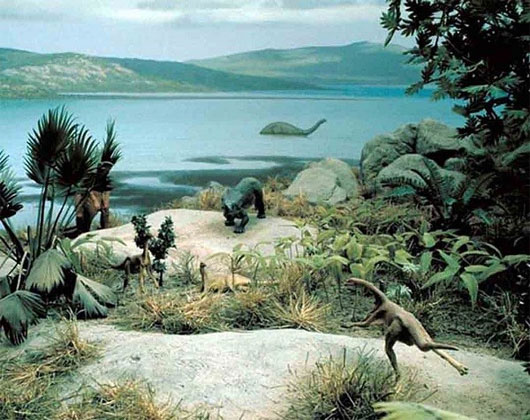
Based on archaeological evidence accumulated through research, scientists hypothesize that this extinction event was caused by one or more simultaneous disasters, such as the strong impact of meteorite fish (creating the Chicxulub craters in Mexico, Boltysh in Ukraine) or due to falling sea levels, powerful volcanic eruptions created the “Deccan trap” phenomenon that seriously devastated the Earth’s biosphere.
Those geological events reduced the amount of light and the level of photosynthesis, leading to the destruction of Earth’s ecosystem on a large scale. As the climate gets drier, the food chain is also broken.
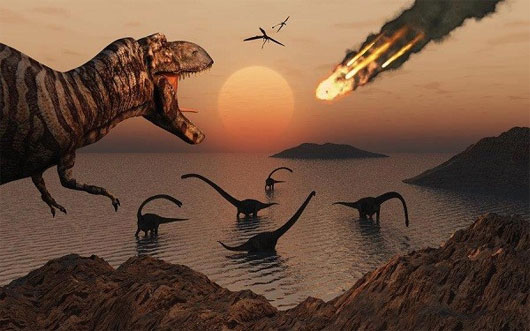
Dinosaurs were the first vertebrates to be affected when the environment changed, and species diversity decreased significantly. Along with that, some species of plants and invertebrates also disappeared on Earth, creating conditions for mammals to develop and gradually dominate.
The Cretaceous – Paleogene extinction was uneven in nature. There are creatures that are completely extinct, others that are severely affected, and the rest that suffer almost no significant impact.
Why do mass extinctions happen?
In general, when the biosphere is subjected to extreme pressures over long periods of time, it can lead to mass extinctions. The higher the biodiversity, the more likely it is to cause mass extinctions, and the more likely it is that disturbances will create a global mass extinction event.
In 2006, Allens and West proposed the “stress pulse” model, in which mass extinctions typically have two causes: one is stress – prolonged pressure on the ecosystem; The second is a period of stress that suddenly occurs and ends – Pulse. Their analysis of ocean-wide extinction rates shows that sustained pressure or sudden catastrophic events alone are not enough to cause a significant increase in extinction rates!
General patterns of extinction
Many scientists believe that mass extinctions are regular events, meaning they occur periodically. For example, Raup and Sepkowski’s 1984 paper “Mass Extinctions of Species in Geological History” showed that every 26 to 30 million years, a mass extinction event occurs. .
In 2005, Rhodes and Mahler published the paper “The Cycle of Fossil Diversity” and proposed that the cycle of mass extinction was 62 million years.
Explanations for the cyclic cause of the mass extinction include fluctuations in the plane of the Milky Way, spiral arms crossing the Milky Way, and fluctuations in geochemical variables. However, data on marine mass extinctions are not consistent with this periodicity, so the existence of a general pattern of mass extinctions is only a scientific hypothesis and has no evidence to support it. prove that.
Will there be a 6th Great Extinction?
All extinctions in history are caused by nature and occur cyclically. Each collapse simultaneously opens a new era, creating conditions for the development of many creatures with strong vitality. The question scientists are asking is, will the 6th mass extinction occur?
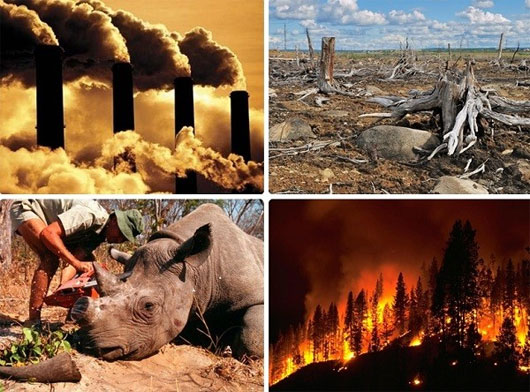
And in fact, it is showing signs of starting… This time it is not nature anymore, but humans who are committing “suicide” . It will not be volcanic eruptions, meteorite collisions, or sudden sea level changes, but environmental pollution, habitat degradation, ecological imbalance, climate change…
The current rate of extinction is 4,000 times faster than the time of the dinosaurs, all human impacts leave severe consequences for nature, which are difficult to recover from. Over-exploitation of resources without conservation and preservation has gradually caused the loss of life in the entire living world.
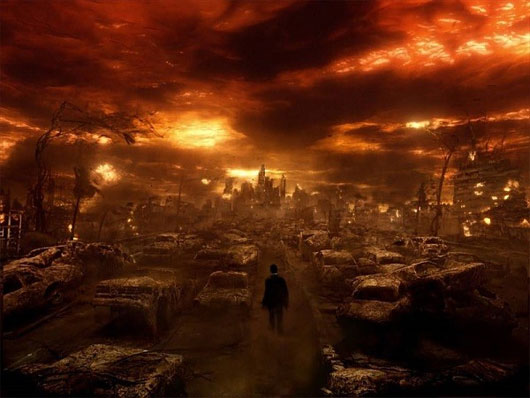
Scientists predict that if the situation continues, in less than a century, the mass extinction will officially begin, and humans will suffer the same fate as the dinosaurs. But will people be lucky to survive after that extinction and life will be restored?





